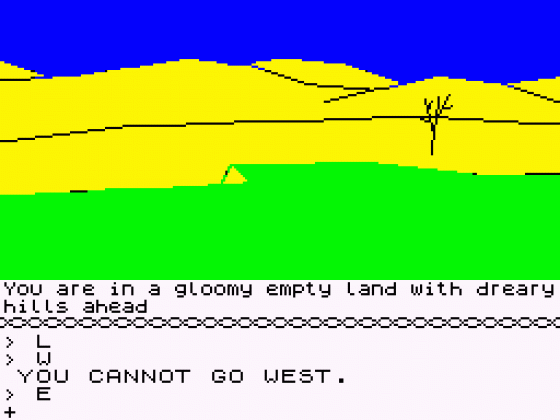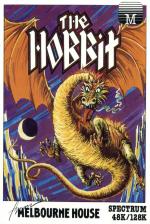
ZX Computing
 1st April 1983
1st April 1983
Categories: Review: Software
Author: Phil Garratt
Publisher: Melbourne House
Machine: Spectrum 48K/128K
Published in ZX Computing #6
Phil Garratt, after a brief sojourn in Middle Earth, takes time off to tell us what he found there
The Hobbit
Once upon a time, a young professor, bored to distraction with marking School Certificate exam papers, wrote on a blank sheet of paper 'In a hole in the ground there lived a Hobbit'. That was over fifty years ago, and at the time neither the professor, J R R Tolkien, nor anyone else had any idea what a hobbit was. Eventually the story was told, and ever since, The Hobbit has been one of the most popular and best-loved children's books. Its popularity and that of The Lord Of The Rings which followed, is matched only by the seriousness with which some Tolkien fans dissect the books for allegorical meaning, never intended by the author. So it takes a brave group of people to set out on an eighteen month adventure to re-write The Hobbit as a computer game. Fortunately for 48K Spectrum owners, the team at Melbourne House have managed it, and in pretty good style too.
You may wonder how it could have taken eighteen months, when the Spectrum has been available for less than a year. The answer is that the program was originally being developed on a TRS-80, but was converted to the Spectrum in order to make use of high resolution colour graphics. The plot of the adventure has been designed to follow the original book as closely as possible, in fact to such an extent that a copy of the book is supplied with the program in order to provide additional clues. Also part of the package is a sixteen page book of instructions, although if you find the prospect of digesting them not to your liking, there's nothing to stop you rushing headlong into the enterprise. After all, that's what Bilbo did! The instruction book is well-structured and clearly laid out, although disappointingly lacking in hints!
Enter The Dragon
The game is set in Middle Earth during its Third Age, when it was inhabited by all manner of creatures, long before the world was overrun by Man. You take the role of Bilbo, the hobbit of the title, and your task is to steal treasure from a dragon, 'a most specially greedy, strong and wicked worm called Smaug'. In the book, Bilbo has thirteen dwarves to help him get there and (hopefully) back again, but in the program you have just one companion, Thorin Oakenshield. He is an 'enormously important dwarf' not least because we are warned that if he gets killed, Bilbo is most unlikely to survive. Along the way you will meet elves, wolves and orcs as well as the famous wizard, Gandalf the Grey, who is usually not far away.

The program is written in 40K of machine code and data, so it takes about four minutes to load. While you are waiting, you have an impressive picture to look at of Smaug and the Lonely Mountain which contains his lair. The program starts by drawing a colour picture of Bilbo's nice bright hobbit-hole, complete with round green door and wooden chest waiting to be filled with dragon's plunder.
The use of graphics is one of the features which makes The Hobbit special. The adventure contains something like 80 locations, of which no less than 30 are illustrated. The graphics are based on drawings commissioned from the artist Kent Rees, and whie none of them are quite as elaborate as the picture of Smaug, they do contain a remarkable amount of detail. By using special techniques, each picture is stored in only 3,000-4,000 bytes. The outline is drawn very quickly, but the filling in with colour is done line-by-line and so does take a few seconds. It can be slightly tedious when the same picture keeps being re-drawn, but ths is only a minor drawback so the addition of graphics as good as these adds a whole new dimension to the adventure.
Picture This
Once you have admired the pretty picture, pressing any key gives the written description of the location. This also has some special features. Firstly, the screen is split into two 'windows', the top seventeen lines being used for the illustrations, the narrative descriptions and responses from the various characters. This is in upper and lower case, and by redefining the character set, the output is displayed with 42 characters per line. The bottom five lines make up the 'communication window' in which you type your commands and if the computer doesn't understand or cannot carry out your request, a message is displayed here. The lower display is made up of standard 32 characters per line captials. Some keys have special meanings - '?' means repeat the command, 5, 6, 7 and 8 can be used to move West, South, North and East, 0 deletes the last character entered and Shift-0 deletes the whole line.

Commands are entered using what the authors have named Inglish, which they claim is the most sophisticated natural language recognition program yet developed on any micro. You can enter quite long sentences, such as 'Attack the warg carefully with the knife' and 'Pick up the rope and sword'. More than one sentence can even be entered, up to a maximum of 128 characters. The authors claim a vocabulary of more than 500 words, which is extraordinarily large. Yet, despite the size it is very quick, although the system is not perfect. For example, 'light' is a command common to many adventures, and is accepted in The Hobbit, although nothing happens and the curious message 'You light' is displayed. Similarly, if you attempt to cross the enchanted river by saying 'Cross', the program says 'You cross'. But, when you look around you, you find that you are, in fact, still stuck on the original side.
Cries For Help
Several special commands are also available. 'Print' copies everything in the upper, narrative window to te printer. The graphics displays are not copied, which is perhaps just as well as it would slow down the game if they were, and also the black and whte result wouldn't do justice to the colourful designs. Your commands are not sent to the printer, so you cannot necessarily use the output to follow an earlier path. Still, Bilbo is meant to be fond of making and reading mags! 'No print' turns the printer off. 'Save' saves your current position on tape; just the necessary data is saved, so it only takes thirty seconds. The program doesn't use the standard ROM routine, and I found that the tape position was important as starting too early gave a tape loading error. The data saved can also be verified before continuing, and is re-entered with 'Load'.
'Score' tells you how far into the adventure you have delved, based on the percentage of the locations you have discovered. I never managed to get very far at all before a troll, warg or some other unidentified creature drastically rewrote the book by killing me off and sending me back to the start. 'Help' is a very useful command, and will quite often give a hint as to the way out of your latest predicament.
Two other features of The Hobbit that the authors are very proud of are 'Animtalk' and 'Animaction'. The first allows you to speak to anyone present so, for example, you can enter 'Say to Thorin "examine the map"' and he will either respond or say 'No', depending on his mood. 'Animaction' refers to the fact that all the animals and individuals have an independent character and will be moving around and making decisions on their own, without waiting for you to do anything. So far about the only animaction I have witnessed is Gandalf behaving uncharacteristically indecisively, by continually giving and then taking back a curious map. Also, Thorin seems to either wait, enter, say 'Hurry up' or start singing about gold, apparently at random.
A Wizard Game
Despite having only explored little more than an eighth of 'Wilderland', I have seen nine graphic locations and picked up which I assume will have some purpose. I haven't yet found a way into the roots of the Misty Mountains, but I hope I will as I greatly look forward to the riddle contest with Gollum (incidentally, the riddles are different to the ones in the book, not surprisingly!). At a couple of recent micro exhibitions I have noticed that the staff on the Sinclair stand (when not selling hundreds of Spectrums!) have been deeply engrossed in playing The Hobbit rather than any of the dozens of other programs available on their stand. The fact that they had neither solved nor tired of this program says quite a lot! It is certainly a marvellous game, which should set the standard for future Spectrum adventures. However, in spite of the excellent graphics and packaging, I feel that £14.95 is a rather high price for a program which is clearly going to sell many thousands of copies.
Other Reviews Of The Hobbit For The Spectrum 48K/128K
The Hobbit (Melbourne House)
A review
The Hobbit (Melbourne House)
A review
The Hobbit (Melbourne House)
A review
The Spectrum Collection
Tony Hetherington selects fifteen classic games that all Spectrum owners should have
The Hobbit (Sinclair Research)
A review by Sudders (Classic Adventure Solutions Archive)











